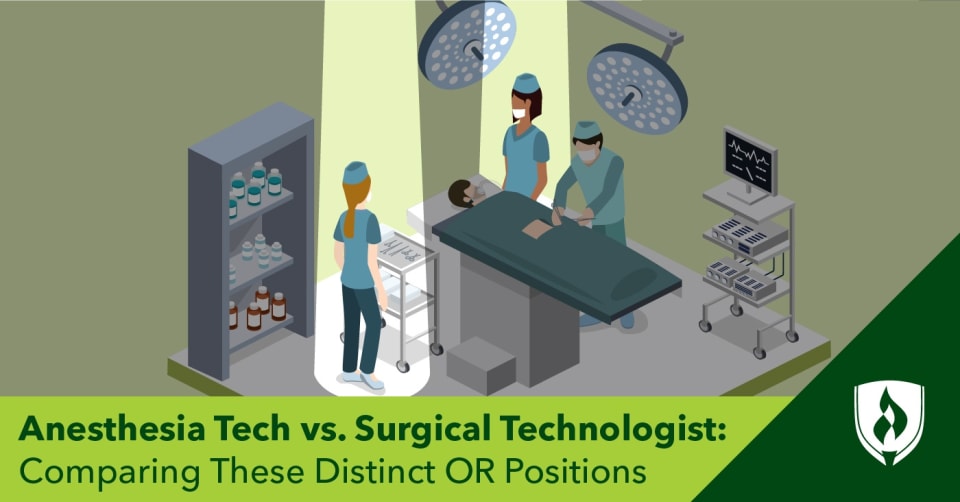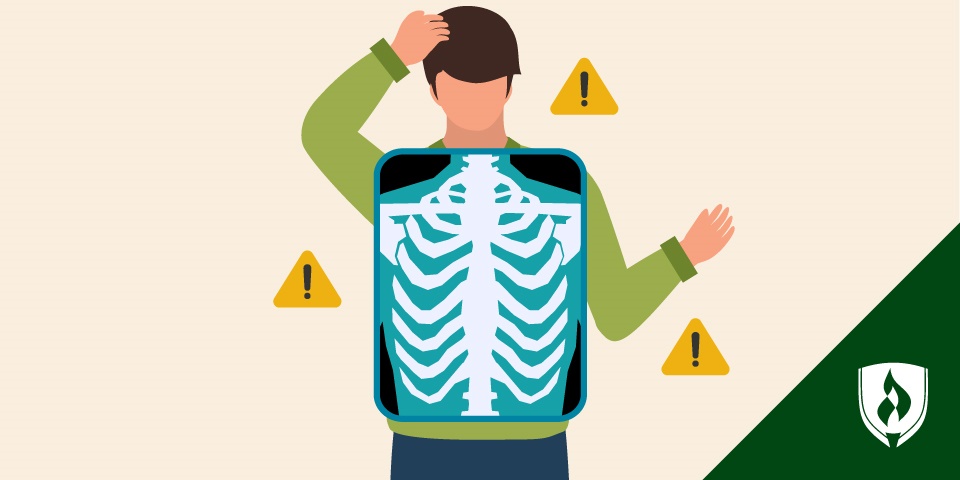Anesthesia Tech vs. Surgical Technologist: Comparing These Distinct OR Positions
By Ashley Brooks on 04/19/2021

With so many job titles in the healthcare field, it’s no wonder that people don’t always have a great handle on who’s responsible for what. While operating room (OR) jobs are certainly some of the more intriguing healthcare career options out there, most people understandably don’t have a lot of visibility into what these roles require. In this article, we’ll be pitting two distinct OR roles head-to-head—anesthesia techs versus surgical technologists—to help explain. Although these healthcare workers are often found on a team together in the operating room, their responsibilities differ greatly!
So what do anesthesia techs and surgical technologists actually do? How do their job duties differ in the OR, and do they require different levels of education and training?
We’re bringing you some additional clarity on the differences between anesthesia techs and surgical technologists to help you decide which career option could be a better fit for you. Keep reading to get the full rundown of these distinct OR careers!
Anesthesia tech vs. surgical technologist: Job duties
What does an anesthesia tech do?
Before we can answer this, we first need to do some clarification. The term “anesthesia tech” can sometimes be used loosely to describe either anesthesia technicians or anesthesia technologists. While that might seem strange, there’s a reason for this. Historically, these roles have not always had a standardized scope of practice or education requirements.1 The American Society of Anesthesia Technologists and Technicians is a professional organization working toward the goal of standardization through certification and can provide an in-depth breakdown of these roles’ scopes of practice.2 For the purposes of this comparison, we’ll focus on information related to anesthesia technologists.
As you might guess, their job duties revolve around supporting the process of administering anesthesia. These healthcare workers have the behind-the-scenes work of making sure any necessary tools and equipment are available and in working order. This includes stocking the OR with necessary medications and gases and calibrating anesthesia delivery systems. Technologists may also be involved with monitoring patients and provide assistance to patients post-anesthesia.
Though a hospital OR might be the first place you'd expect to find them, it's certainly not the only place. Anesthesia is also needed in places like dentists’ offices and surgical outpatient clinics. It’s also important to note that anesthesia techs sometimes work with patients who are awake, such as in the case of an epidural during labor or other anesthetic spinal injections.
What does a surgical technologist do?
Surgical technologists, on the other hand, assist with other aspects of surgeries, not just those related to anesthesia. They help prep the OR by sterilizing equipment, ensuring that the necessary supplies are in stock and preparing medications that will be needed during surgery.
They’re also responsible for prepping patients before surgery begins, including transporting them to the OR and disinfecting incision sites—not to mention double-checking important details, like ensuring they’re planning the correct surgery for the correct patient!
Surgical technologists take an active role during operations by passing tools and supplies to surgeons and keeping careful track of each tool that is used to ensure that nothing is accidentally “left behind” inside a patient.
After an operation is over, the process is reversed, with surgical technologists tidying up and sterilizing the OR and transferring patients to their recovery areas. Like anesthesia techs, surgical technologists are most likely to work in a hospital setting, though some also work in outpatient clinics.
Anesthesia tech vs. surgical technologist: Job outlook
Like with many other healthcare careers, both anesthesia techs and surgical technologists are enjoying a favorable job outlook as the aging baby boomer population requires more essential surgeries and opts to have elective surgeries, such as knee replacements, that can improve quality of life as they age.3
While the Bureau of Labor Statistics (BLS) doesn’t offer specific salary and job outlook information for anesthesia techs, they do offer information for the broader subcategory, “Health Technologists and Technicians,” that can provide some generalized insight. Employment of professionals in the group is projected to grow by eight percent from 2019 to 2029, according to the BLS.3 Employment of surgical technologists is projected by the BLS to grow seven percent during the same time period.3 These rates are both faster than the national average.
Aesthesia tech vs. surgical technologist: Education and training needed
How do you become an anesthesia tech?
The education and training needed to become an anesthesia tech will depend on the specific role. Anesthesia technologists typically need to complete an Associate’s degree or certificate program through an accredited institution. Some employers may allow anesthesia technicians to get started with a high school diploma or GED in combination with on-the-job training, but this is becoming less common as standardized training programs are more widely available.
Some employers may also require or prefer certification to verify that you have a certain level of skill and expertise in the field. Certification for anesthesia technologists is offered by the American Society of Anesthesia Technologists and Technicians (ASATT). The ASATT no longer offers certification for anesthesia technicians, but becoming a member of this professional organization can still give you continuing education opportunities that are valuable to employers.
How do you become a surgical technologist?
The first step to entering the OR as a surgical technologist will require formal education, typically in the form of a diploma or Associate’s degree program. This education will give you the training you need in knowing how the OR works, the necessary tools and instruments, and how to work with patients. Though the amount of time this takes varies by program, the Rasmussen University Surgical Technologist Associate’s degree can be completed in as few as 21 months.4
With the right degree under your belt, you’re ready to begin work and become a Certified Surgical Technologist (CST) if you choose. Although this certification is optional, it can show employers that you’re well versed in the field and take your career seriously. Certification is administered by the National Board of Surgical Technology and Surgical Assisting and requires passing an exam.5
Anesthesia tech vs. surgical technologist: Skills needed
If these two careers still seem neck and neck, the skills required on the job could be the tiebreaker. Although both roles will require similar characteristics, like attentiveness, there are some key differences that can help set them apart.
Anesthesia techs must be organized and meticulous as they focus much of their work on preparing for the upcoming procedures of the day. They stock and prepare all supplies for the day's coming procedures and check to ensure all equipment is working properly. That said they'll also need to be comfortable changing these plans as needed, as sometimes unexpected adjustments must be made. Anesthesia techs must also have high levels of compassion and empathy since they’re often the last person a patient sees before surgery, when they may be feeling nervous about the procedure ahead.
Surgical technologists often serve as a main line of communication to the surgical team during operations. They need excellent verbal communication skills to both understand directions from surgeons and communicate issues that arise to other members of the healthcare team.OR teams also value surgical technologists with strong critical-thinking skills. This allows them to think ahead, anticipating what a surgeon might need next so the surgery can proceed as smoothly as possible.
Which OR role is right for you?
When it comes to choosing between anesthesia tech and surgical technologist, no one else can make the decision for you.
Now that you know the basic similarities and differences of these two OR careers, the next step is to gain personal perspective on the role by hearing from professionals who work in the OR every day. Start with our article “Surgical Technologist Duties: A Day in the Life” to discover if this career could be right for you.
1American Society of Anesthesiologists, ASA Monitor, Anesthesia Technology / Technician Scope of Practice [accessed March 2021]. https://pubs.asahq.org/monitor/article-abstract/82/3/46/6022/Anesthesia-Technologist-Technician-Scope-of
2American Society of Anesthesia Technologists and Technicians, Scope of Practice, [accessed March 2021] https://www.asatt.org/images/pdfs/ASATT-Scope_of_Practice.pdf
3Bureau of Labor Statistics, U.S. Department of Labor, Occupational Outlook Handbook, [information accessed March 2021] www.bls.gov/ooh/. Employment conditions in your area may vary.
4Completion time is dependent on the number of transfer credits accepted and the number of courses completed each term. Program availability varies by campus and state; please see the Rasmussen University Catalog for details.
5At Rasmussen University, graduation from a campus with programmatic accreditation is a requirement to sit for the Certified Surgical Technologist (“CST”) certification through the National Board of Surgical Technology and Surgical Assisting (NBSTSA). The CST certification may be required for state professional licensure or certification. Other eligibility requirements may apply to state and national licenses and certifications; please verify your eligibility against applicable rules, which may change at any time.




